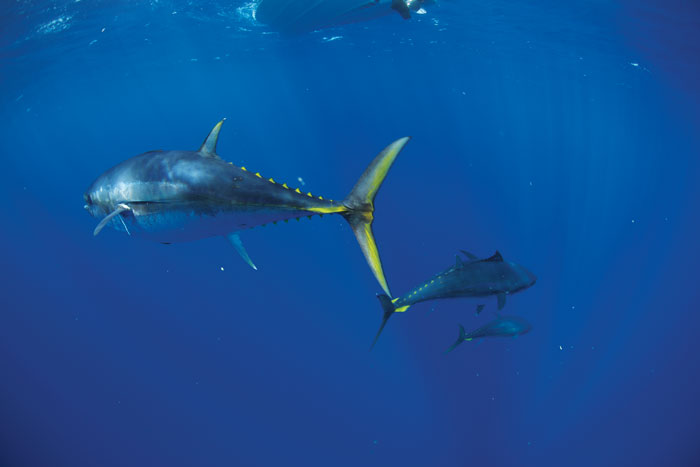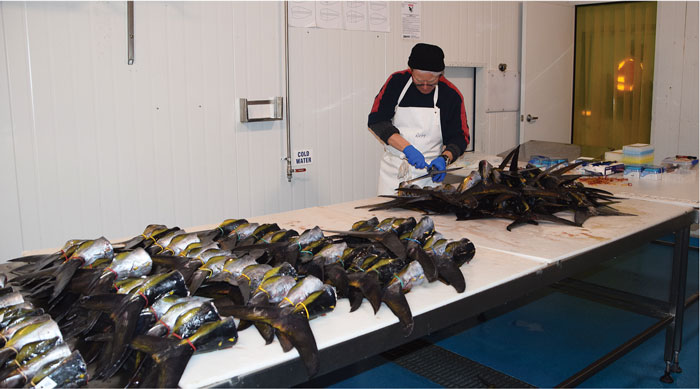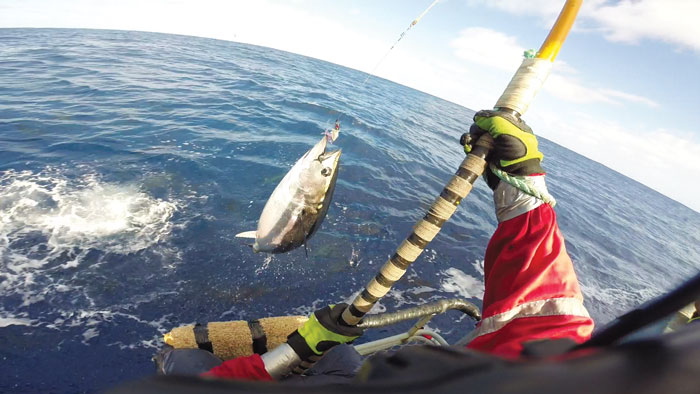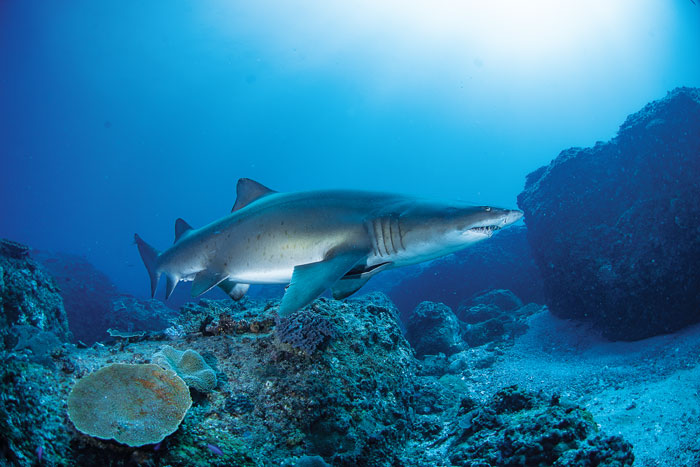An idea lying dormant for years re-emerged at the right time, helping to rebuild global stocks of Southern Bluefin Tuna and revolutionising fisheries stock assessments
Words Bianca Nogrady

Photo: Al McGlashan
Mark Bravington was attending a meeting at the International Whaling Commission in the late 1990s when he first heard of the idea of using genetic matches between parent and offspring to calculate the size of a population.
Norway had amassed a significant database of DNA and tissue samples from whale hunting as a way to keep an eye on illegal whaling. Norwegian statistician Hans Skaug had twigged that this DNA database could be analysed for matches between parent minke whales and their offspring, and that the greater the number of these familial connections that turned up in the database, the smaller the population must be .
“The idea struck me as completely brilliant,” says Bravington, a statistician at CSIRO in Hobart. The only problem was, it did not work.
“It was the right idea but at the wrong time. Genetic technology wasn’t advanced enough to deliver on the potential. It was also the wrong species: it didn’t work in minke whales for a variety of reasons.”
So that brilliant idea died, and Bravington forgot all about it.
Five years later, he was working on Southern Bluefin Tuna (SBT) (Thunnus maccoyii), trying to assess just how healthy or unhealthy stocks were, and it was not going well. “It was just an awful mess and extremely contentious,” he recalls.
Revelations of large, unreported catches had undermined the data used to assess the stock. There were also worrying signs that the spawning stock and recent year classes were the lowest on record.
Bravington recalled the Norwegian minke whale study, and wondered if it might work in tuna. He took the idea to geneticist colleague Peter Grewe, and the two of them put forward a proposal to CSIRO to explore it.
First steps
With additional funds from the FRDC they undertook the first major survey of SBT using this approach. The study was based on about 14,000 tissue samples taken from fish caught by commercial fishers. It took five years to complete and identified 45 parent–offspring pairs. The results showed the species was slightly more abundant than previously thought.
That technique – now called close-kin mark-recapture – looks set to revolutionise the way the health and productivity of fisheries are assessed.
“Close-kin mark-recapture is a census, and a very reliable and precise one if sufficient kin pairs are retrieved,” says Grewe.
The beauty of this method lies in its simplicity. At its core is the genetic and mathematical truth that the greater the proportion of related individuals found in a random sample of a population, the smaller that population must be.
“Every fish has two parents,” says Campbell Davies, who leads CSIRO’s international fisheries research. “And every fish genetically ‘marks’ or ‘tags’ its parents via its DNA.”
Matching a parent to its offspring is genetically easy to do and very accurate. Researchers collect a predetermined number of tissue samples from a population of fish. The number of samples is decided based on available estimates of the size of that population and the species’ life history. Researchers then count how many parent–offspring matches they find.
The more matches they find, the smaller the population, because the smaller the population, the higher the probability of both the parent and the offspring being in the sample.
Conversely, if they find relatively few matches, that generally means the population is large and therefore the chance of coming acrossoth an offspring and one of its parents in the same sample is much smaller.
Simple. But that does not mean that first application to SBT was easy.
“It was really a massive slog on that first attempt,” Bravington says.
“It took us six years to get something out of it, from convincing funders and stakeholders that it was plausible, developing the markers to reliably identify kin with really high confidence, to processing and analysing the results.”
The technique relies on a solid understanding of the dynamics, reproductive biology and spatial distribution of a fish population. For example, Atlantic Bluefin Tuna (Thunnus thynnus) spawn at three different sites in the Mediterranean Sea, so a sample from only one of those sites would not provide a true representation of the entire population.
It also requires at least a rough estimate of the species’ population size to calculate how many samples might be needed to get sufficient close-kin matches for reliable estimates.
As a rule of thumb, researchers aim for sample sizes that are likely to result in 50 to 100 kin matches.
The right timing
Despite the challenges, it was the right time for close-kin mark-recapture to evolve and, most importantly, SBT was the right species to demonstrate its value in. Scientists trying to get a handle on the actual numbers of SBT had long relied on traditional sources of abundance information, in particular fisheries-dependent catch per unit effort from the main longline fisheries.
Revelations of unreported catches in 2006 meant scientists were unable to conduct a conventional stock assessment at a time when there was consistent evidence the population was struggling.
This meant there was a strong drive for both scientists and stakeholders to find a method that did not rely on commercial catch-and-effort data and that could provide direct estimates of the abundance of the successful spawners – a primary objective of fisheries management.
Close-kin mark-recapture represented a solution to this crisis. “The data is a strict sampling of the fish in the ocean, or from the processing plant, and the DNA does the talking,” Grewe says. “It is totally independent of how people are fishing, or how many trips they do, what sort of hooks they’re using.”
From a stakeholder perspective, CEO of the Australian Southern Bluefin Tuna Industry Association Brian Jeffriess says the close- kin technology and its scientific independence have been critical to the rebuilding of SBT stocks over the past 15 years.
SBT is managed through the Commission for the Conservation of Southern Bluefin Tuna, and it was this “groundbreaking science” that validated the biomass, Jeffriess says. It gave all international partners in the fishery the confidence to agree to much-needed management changes.

Photo: Supplied Russ Bradford
Refining techniques
Since that first study, both the technique of close-kin mark-recapture and its applications have expanded. Researchers are now getting far more information out of those tissue samples than simply a paternity or maternity test.
When geneticist Pierre Feutry joined the team at CSIRO, the genetic approach being used looked for microsatellites in the DNA – simple repetitive sequences in the genetic code that are passed from parent to offspring.
The first study looked for microsatellite matches at 20 to 25 locations – or loci – in the fish genome, which is roughly the same number of loci that are examined in human paternity testing.
But the team wanted to expand their matching to siblings and half-siblings, and with a very high confidence. “So the requirements were higher and there was a need for more markers,” Feutry says. The answer was single nucleotide polymorphisms, or SNPs: a variation at a single point on a strand of DNA, like the change of a single letter in a book.
To do this, “thousands of loci have to be sequenced, but it provides far more information than a couple of dozen microsatellites. And with improvement in technologies, it is both cheaper, faster and, importantly, digital,” says Feutry.
That opened the door to identifying juveniles who share one or – much more rarely – two parents, which reveals much more about the status and dynamics of that fish population.
For example, if one juvenile is identified in 2021 and their juvenile half-sibling is identified in 2023, that means that one of their parents survived at least three years. It is even possible to tell whether they share a mother or a father, which provides sex-specific information about population dynamics.
“By a complicated route, you get information about abundance of the parents that is statistically independent of the parent–offspring information, and you’re also getting information about mortality of the adults that you’ve never seen,” Davies says.
“This is a major strength of the approach. By using both these types of kin relationships you can test some of the fundamental assumptions about the sampling, because they’re completely independent.”
The combination of parent–offspring and half-sibling pairs not only provides two independent assessments of how abundant the adults are, but also, through the sibling data, sheds light on mortality rates in adults and the reproductive success of the adults relative to their size and age.
“These are essentially the four critical ingredients for a stock assessment and fisheries management, and essentially fishery independent,” Davies says.
Broader applications
The success of close-kin mark-recapture in SBT has attracted global interest in its application in large commercial fisheries. Studies are underway for the Atlantic Bluefin Tuna and Northern Bluefin Tuna (Thunnus orientalis) fisheries.
It has also been applied to a range of conservation-listed and commercial shark species. In 2014, the FRDC funded a study using the technique to estimate the abundance of School Shark (Galeorhinus galeus), which used to be a fish and chips favourite until dwindling numbers led to substantial fishing reductions.
Other shark species assessed include White Shark (Carcharodon carcharias), Northern River Shark (Glyphis garricki), Speartooth Shark (Glyphis glyphis) and Greynurse Shark (Carcharias taurus). These are all listed as ‘depleted’ in Australia’s Shark Report Card.
As genetic technology improves and becomes cheaper, so too does the application of close-kin mark-recapture. It can theoretically be applied to almost any species, marine or terrestrial – with certain notable exceptions such as the nine-banded armadillo, which gives birth to identical quadruplets – provided the populations are not so small as to be almost non-existent or so large, such as some small pelagic species, as to make finding a match very difficult.
Word of close-kin mark-recapture is spreading, with dozens of projects underway or in development worldwide. The CSIRO team is highly sought after to help with new projects or deliver courses. Bravington says they cannot keep up with the demand.
“The challenge now is getting the information and the expertise out there and continuing to build the capacity for wider applications, because there is no shortage of interest.” f
The technique relies on a solid understanding of the dynamics, reproductive biology and spatial distribution of a fish population. For example, Atlantic Bluefin Tuna (Thunnus thynnus) spawn at three different sites in the Mediterranean Sea, so a sample from only one of those sites would not provide a true representation of the entire population.

Photo: Russ Bradford

Photo: Shutterstock
R&D Plan Outcome 2
Best practices and production systems
More information
Mark.Bravington, Mark.Bravington@data61.csiro.au
FRDC Research Codes
2007-034, 2014-024, 2019-016, 2017-098, 2016-018, 2016-044, 2017-021





